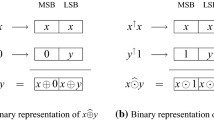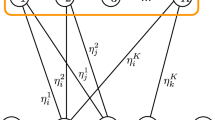Abstract
The influence of a clipping procedure on the properties of vector associative memory is investigated. The analysis is performed for the particular case of a phase model of a parametric neural network with 2q-state neurons. The critical network size N c is found. It is shown that, for small network sizes (N < N c ), the clipping leads to an increase of the storage capacity and enhances the network ability to retrieve strongly distorted patterns. Clipping of bigger networks (N > N c ) leads to a deterioration of the recognition ability and reduces the storage capacity.
Similar content being viewed by others
References
I. Kanter, “Potts-Glass Models of Neural Networks,” Phys. Rev. A 37(7), 2739 (1988).
J. Cook, “The Mean-Field Theory of a Q-state Neural Network Model,” J. Phys. A 22, 2000 (1989).
H. Vogt and A. Zippelius, “Invariant Recognition in Potts-Glass Neural Network,” J. Phys. A 25, 2209 (1992).
D. Bolle, P. Dupont, and J. van Mourik, “Stability Properties of Potts Neural Networks with Biased Pattern and Low Loading,” J. Phys. A 24, 1065 (1991).
D. Bolle, P. Dupont, and J. Huyghebaert, “Thermodynamic Properties of the q-State Potts-Glass Neural Network,” Phys. Rev. A 45, 4194 (1992).
F. Y. Wu, “The Potts Model,” Rev. Mod. Phys. 54, 235 (1982).
B. V. Kryzhanovsky and A. L. Mikaelian, “On the Recognition Abilities of a Neural Network Using Neurons with Parametric Frequency Transformation,” Dokl. Akad. Nauk, Ser. Matem. Physics 383(3), 318 (2002).
B. V. Kryzhanovsky, V. M. Kryzhanovsky, A. L. Mikaelian, et al., “Parametric Dynamic Neural Network Recognition Power,” Optical Memory and Neural Networks 10(4), 211 (2001).
B. V. Kryzhanovsky and A. L. Mikaelian, “An Associative Memory Capable of Recognizing Strongly Correlated Patterns,” Dokl. Akad. Nauk, Ser. Informatics 390(1), 27 (2003).
B. Widrow and M. E. Hoff, Jr., “Adaptive Switching Circuits,” in 1960 IRE Western Electric Show and Convention Record, Part 4, 96 (1960).
H. Sompolinsky, “Neural Network with Non-linear Synapses and Static Noise,” Phys. Rev. A 34 2571 (1986).
J. L. van Hemmen, “Nonlinear Neural Network near Saturation,” Phys. Rev. A 36 1959 (1987).
W. Kintzel and M. Opper, “Models of Neural Networks I,” in Physics of Neural Networks, Ed. by E. Domany, J. L. van Hemmen, and K. Schulten (Springer, Berlin, 1995) p. 170.
J. J. Hopfield, “Neural Networks and Physical Systems with Emergent Collective Computational Abilities”, Proc. Nat. Acad. Sci. USA 79, 2554 (1982).
Author information
Authors and Affiliations
Corresponding author
Additional information
Boris Vladimirovich Kryzhanovsky was born in 1950 in Yasnaya Polyana in the Tula region of Russia and graduated (with an M.Sc.) from Yerevan State University in 1971. He received his Ph.D. (Optics) in 1981 and his D.Sc. (Laser Physics) in 1991. At the present time, he is the director of the Center for Optical Neural Technologies of the Scientific Research Institute for Systems Analysis of the Russian Academy of Sciences. His research interests include neural networks. He is a corresponding member of the Russian Academy of Sciences and the author of over 200 research publications.
Vladimir Mikhailovich Kryzhanovsky was born in 1984 in Kirovakan, Armenia and graduated (with an M.Sc.) from the Moscow Engineering Physics Institute in 2007. At the present time, he is a junior research assistant at the Center for Optical Neural Technologies of the Scientific Research Institute for Systems Analysis of the Russian Academy of Sciences. His research interests include Neural Networks, and he is the author of over 20 research publications.
Dina Igorevna Simkina was born 1981 in Buinaksk in Dagestan, Russia and graduated (with an M.Sc.) from Dagestan State University in 2003. At the present time, she is a junior research assistant at the Center for Optical Neural Technologies of the Scientific Research Institute for Systems Analysis of the Russian Academy of Sciences. Her research interests include neural networks, and she is the author of over 20 research publications.
Rights and permissions
About this article
Cite this article
Kryzhanovsky, B.V., Simkina, D.I. & Kryzhanovsky, V.M. A vector model of associative memory with clipped synapses. Pattern Recognit. Image Anal. 19, 289–295 (2009). https://doi.org/10.1134/S1054661809020126
Received:
Published:
Issue Date:
DOI: https://doi.org/10.1134/S1054661809020126




